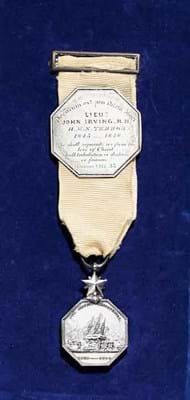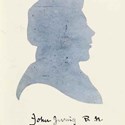"Whatever happens is the will of God. I hope you do not think me so weak as to labour under any presentiment of evil; but remember this is no common voyage... two years is a long time without any tidings, and perhaps we may be three years at least. Do not give up on us if you hear nothing."
This message that Lt John Irving wrote to his sister in April 1845 confirmed he was well aware of the dangers he was to face as Third Officer on the expedition.
Irving (1815-c.1848) served on HMS Terror, which, along with HMS Erebus, crewed by 129 men in total, disappeared into the Arctic ice, leading to numerous search expeditions over the following years and an enduring mystery.
Now his Arctic Medal is being offered at Christie's South Kensington on October 8.
The Arctic Medals were granted by Queen Victoria in 1857 to 'all Persons, of every rank and class, who have been engaged in the several Expeditions to the Arctic Regions... between the years 1818 and 1855'. Overall, 1486 honours were awarded, including 1106 to Royal Navy recipients and others to French and US Navy and Hudson's Bay Company personnel who took part in Franklin searches.
The medal, estimated at £20,000-30,000 in Christie's travel, science and natural history offering, was awarded posthumously to Irving, who was actually the first identifiable victim of Franklin's expedition - in 1879 Lt Frederick Schwatka's American search party found next to his body a silver medal engraved Second Mathematical Prize, Royal Naval College. Awarded to John Irving Mid-summer. 1830. His bones were then reinterred in his native Edinburgh.
From the arrival of the last letter from Upernavik, dated July 10, 1845, until the discovery of his skeleton, Irving's fate had remained unknown.
Photographic evidence
Further light will now be shed on the expedition after the discovery of one of the two ships. It is unclear which one had been found, but detailed photographic evidence has confirmed the discovery.
The BBC reported: "The Canadian government began searching for Franklin's ships in 2008 as part of a strategy to assert Canada's sovereignty over the Northwest Passage, which has recently become accessible to shipping because of melting Arctic ice.
"Expedition sonar images from the waters of Victoria Strait, just off King William Island, clearly show the wreckage of a ship on the ocean floor."
The wreck is in good condition about 11 metres underwater. It is standing upright on the seabed, mainly intact except for her three masts, and two bronze cannon.
A video of the wreck can be viewed on the Toronto Star website.









